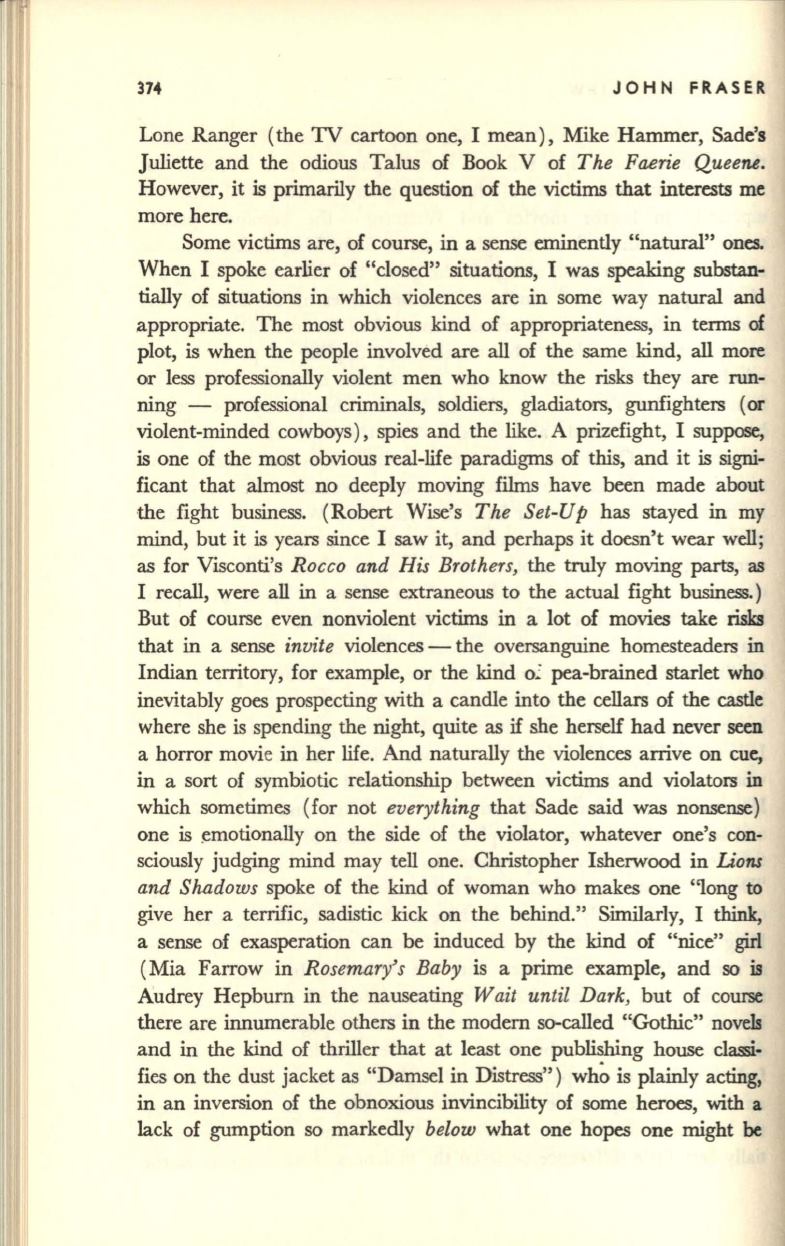
374
JOHN FRASER
Lone Ranger (the
'IV
cartoon one, I mean), Mike Hammer, Sade's
Juliette and the odious Talus of Book V of
The Faerie Queene.
However, it is primarily the question of the victims that interests me
more here.
Some victims are, of course, in a sense eminently "natural" ones.
When I spoke earlier of "closed" situations, I was speaking substan–
tially of situations in which violences are in some way natural and
appropriate. The most obvious kind of appropriateness, in terms of
plot, is when the people involved are all of the same kind, all more
or less professionally violent men who know the risks they are run–
ning - professional criminals, soldiers, gladiators, gunfighters (or
violent-minded cowboys), spies and the like. A prizefight, I suppose,
is one of the most obvious real-life paradigms of this, and it is signi–
ficant that .almost no deeply moving films have been made about
·the fight business. (Robert Wise's
The Set-Up
has stayed in my
mind, but it is years since I saw it, and perhaps it doesn't wear well;
as for Visconti's
Rocco and His Brothers,
the truly moving parts, as
I recall, were all in a sense extraneous to the actual fight business.)
But of course even nonviolent victims in a lot of movies take
risks
that in a sense
invite
violences - the oversanguine homesteaders
in
Indian territory, for example, or the kind
0:
pea-brained starlet who
inevitably goes prospecting with a candle into the cellars of the castle
where she is spending the night, quite as
if
she herself had never seen
a horror movie in her life. And naturally the violences arrive on cue,
in a sort of symbiotic relationship between victims and violators
in
which sometimes (for not
everything
that Sade said was nonsense)
one is emotionally on the side of the violator, whatever one's con–
sciously judging mind may tell one. Christopher Isherwood in
Lions
and Shadows
spoke of the kind of woman who makes one "long to
give her a terrific, sadistic kick on the behind." Similarly, I
think,
a sense of exasperation can be induced by the kind of "nice"
girl
(Mia Farrow in
Rosemary's Baby
is a prime example, and so
is
Audrey Hepburn in the nauseating
Wait until Dark,
but of course
there are innumerable others in the modern so-called "Gothic" novels
and
in
the kind of thriller that at least one publishing house classi–
fies on the dust jacket as "Damsel in Distress")
wh~
is plainly acting,
in an inversion of the obnoxious invincibility of some heroes, with a
lack of gumption so markedly
below
what one hopes one might
be


